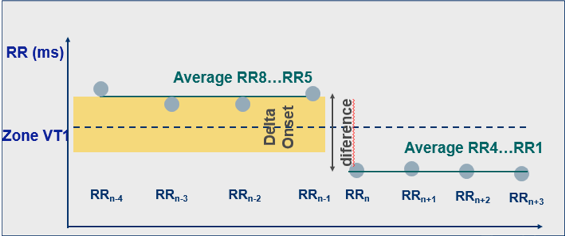Biotronik Discrimination
In this article
As described earlier, the initial detection is based on rate and duration criteria. While heart rate is indispensable, it is insufficient to distinguish ventricular from supraventricular tachyarrhythmias. The application of this criterion in isolation is associated with a 100% sensitivity and a 60% specificity. A more reliable detection depends on discrimination, which is the ability of defibrillators to determine supraventricular versus ventricular origin of an episode of tachycardia, using characteristics like stability of the RR intervals, mode of onset, association atrium to ventricle, and others, programmed alone or in combination. The discrimination algorithms are only applied in the VT zones, where the detection of an episode must be confirmed by VT/SVT discriminators before the delivery of a programmed therapy. In the VF zone, the safety criteria prevail, and the detection of a high ventricular rate in the zone “VF detected” by the defibrillator triggers the programmed therapies, without scrutiny of the episode by an algorithm of discrimination. These algorithms must be activated only in patients at risk of developing a supraventricular tachycardia conducted to the ventricles and, therefore, must be deactivated in patients presenting with complete and permanent atrioventricular block. If all discrimination criteria are activated, the therapy is delivered regardless of the origin of the tachycardia. The design of discrimination algorithms differs between a simple chamber (absence of atrial signal) and a dual chamber defibrillator, and among models. The addition of an atrial lead offers a supplemental and precious detection tool, allowing a continual comparison of the atrial and ventricular cycles. In nominal programming, the detection of an episode, whether supraventricular or ventricular, triggers the memorisation of EGM, signals recorded by the leads accessible upon interrogation of the defibrillator, which allow a critical analysis of its diagnosis and, perhaps, its reprogramming in case a tachycardia was misclassified.
The discrimination by single chamber Biotronik devices is based on an analysis of the arrhythmia onset and the stability of the rhythm. The diagnosis of VT is based on observation of a sudden onset and a stable rhythm.
Suden onset
The sudden onset criterion theoretically allows the discrimination of sinus (gradual onset) from ventricular tachycardia. It does not allow, however, the discrimination of atrial fibrillation or flutter from VT. The average of the last 4 RR intervals is compared with the average of the next 4 RR intervals. The calculation is made on 8 sliding cycles, and the criterion is fulfilled when the difference between the 2 averages is greater than the programmed “sudden onset”, which, by default, is set at 20%. When the sudden onset criterion is verified, it remains valid for all episodes, including for redetections.

Stability
The stability criterion allows theoretically the discrimination of atrial fibrillation (usually irregular) from VT (usually regular). However, it does not discriminate sinus tachycardia, from atrial tachycardia or flutter, from VT. The stability criterion is fulfilled (the rhythm is considered stable) when, for a ventricular cycle, the difference between the RR interval and one of 3 previous RR intervals is shorter than the programmed value. The default setting is 24 ms. The programming of the stability criterion in the VT1 and VT2 zones can be different. The stability criterion is applied during the detection and redetection phases.

The SMART algorithm applies several criteria to discriminate VT from SVT, including the atrial and ventricular rates, the atrial and ventricular rate stability, the multiplicity, i.e. the n:1 A and V ratio and the presence or absence of sudden onset of the arrhythmia. Depending on the analysis of these criteria, the arrhythmia is classified as VT or SVT. For each interval corresponding to a VT zone, the discrimination algorithm undergoes a series of analyses to conclude to a diagnosis of VT versus SVT. An interval classified as VT is labelled VT1 or VT2 depending on the zone of rate in which it belongs. An interval classified SVT is labelled “AFib” for atrial fibrillation, “AFlut” for atrial flutter, SinT for sinus tachycardia, or 1:1 for atrial tachycardia.

Average RR and PP intervals
The SMART algorithm uses sliding windows of 4 cycles in the atrium and in the ventricle to compare these 2 rhythms, which determines whether the ventricular rhythm is faster, identical or slower than the atrial rhythm. For each new interval, the average is recalculated by eliminating the first 4 previous cycles. This analysis is key because, if the ventricular rhythm is found to be faster than the atrial rhythm, the device diagnoses VT without further discrimination.
Criterion of RR and PP stability
While stability is independently determined and programmed in the atrium and the ventricle, the default is 12% in the atrium. An interval is considered stable when the difference between this and the 3 previous intervals is not longer than the programmed value.
Sudden onset criterion
The function is the same as that described for single chamber defibrillators, with a default value = 20%.
Multiple of the PP/RR rate (rapport n/1)
To determine whether atrial flutter with n:1 conduction is present, the defibrillator looks for an n:1 ratio between atrial and ventricular rhythm. A multiplicity (n:1 ratio) is present when the average atrial rate is a multiple of the average ventricular rate (with a 12-ms tolerance).
Criterion of regularity of the PR interval
A PR interval is classified regular if the difference between its duration (PR1) and the duration of the 3 previous PR intervals (PR2, PR3 and PR4) is not greater than the programmed value (6% by default, corresponding to half the stability value).
Monotonous change in PR interval
When the atrial and ventricular rhythms are stable, the device examines whether the PR intervals change according to a characteristic pattern. The PR interval is classified as monotonous when each of 4 previous P-R intervals increase or decrease constantly in respect with each other (AV n < AV n-1< AV n-2 < AV n-3 or AV n > AV n-1> AV n-2 > AV n-3) which indicates the presence of atrioventricular dissociation.


